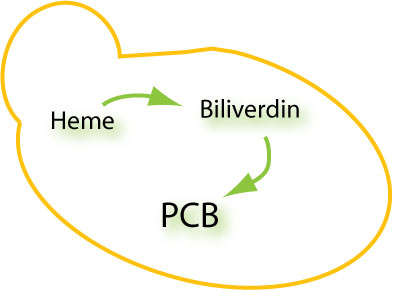Team:MIT/Projects
From 2009.igem.org
(→Project 1: Metabolic Engineering of PCB Synthesis in Yeast) |
|||
| Line 19: | Line 19: | ||
<!-- END RESOURCES HEADER--> | <!-- END RESOURCES HEADER--> | ||
| - | + | Phycocyanobilin (PCB) is a chromophore necessary for PhyB-PIF3 based | |
| + | synthetic devices. Our goal is to engineer a yeast strain capable of | ||
| + | synthesizing PCB, so that no exogenous PCB would be needed for | ||
| + | PhyB-PIF3 to function in yeast. We thus cloned the genes encoding | ||
| + | enzymes in the PCB biosynthetic pathway for expression in yeast | ||
<br> | <br> | ||
[[Team:MIT/Projects/Project1|Link to more details about Project 1]] | [[Team:MIT/Projects/Project1|Link to more details about Project 1]] | ||
Revision as of 02:16, 22 October 2009
Project 1: Metabolic Engineering of PCB Synthesis in Yeast
|
|
Brief DescriptionPhycocyanobilin (PCB) is a chromophore necessary for PhyB-PIF3 based
synthetic devices. Our goal is to engineer a yeast strain capable of
synthesizing PCB, so that no exogenous PCB would be needed for
PhyB-PIF3 to function in yeast. We thus cloned the genes encoding
enzymes in the PCB biosynthetic pathway for expression in yeast
|
Project 2: Rapid & Reversible Protein Localization using PhyB-PIF3 System
|
|
Brief DescriptionOur goal is to engineer a system that adopts the PhyB-PIF3 switch to
control protein localization within the cell. In our design, either
PhyB or PIF3 is constitutively anchored to one of the four target
locations. The other will then be bound to our protein of interest and
diffuse within the cell. Here, we use CFP and YFP to track the
location of PhyB and PIF3, respectively. Reversable, light-dependent
association of PhyB and PIF3 can then be monitored by fluorescence
microscopy. |
 "
"


